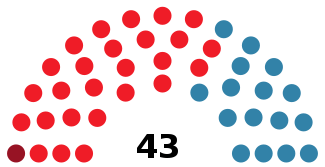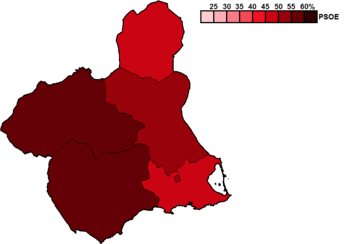Murcian regional election, 1983
| |||||||||||||||||||||||||||||||||
All 43 seats in the Regional Assembly of Murcia 22 seats needed for a majority | |||||||||||||||||||||||||||||||||
| Registered | 675,082 | ||||||||||||||||||||||||||||||||
| Turnout | 462,212 (68.5%) | ||||||||||||||||||||||||||||||||
| |||||||||||||||||||||||||||||||||
|
Constituency results map for the Regional Assembly of Murcia | |||||||||||||||||||||||||||||||||
| |||||||||||||||||||||||||||||||||
The 1983 Murcian regional election was held on Sunday, 8 May 1983, to elect the 1st Regional Assembly of the Autonomous Community of the Region of Murcia. All 43 seats in the Regional Assembly were up for election. The election was held simultaneously with regional elections in 12 other autonomous communities and local elections all throughout Spain.
The Spanish Socialist Workers' Party (PSOE) went on to win a comfortable absolute majority of both seats and votes, emerging as the largest party in the Region. The People's Coalition, an electoral alliance led by the right-wing People's Alliance (AP), which included the People's Democratic Party (PDP) and the Liberal Union (UL), became the second political force and the main opposition party, whereas the Communist Party of Spain (PCE) also entered the Assembly, obtaining 1 seat.
As a result of the election, Socialist Andrés Hernández Ros, who since 1979 had been the President of the Regional Council of Murcia (the pre-autonomic regional government), became the first democratically elected President of the region.
Electoral system
The 43 members of the Regional Assembly of Murcia were elected using the D'Hondt method and a closed list proportional representation, with a threshold of 5 per 100 of valid votes—which included blank ballots—being applied regionally. Parties not reaching the threshold were not taken into consideration for seat distribution. Seats were allocated to constituencies, which were established by law to comprise the following municipalities:
- I–Lorca: Lorca, Aguilas, Puerto Lumbreras, Totana, Alhama de Murcia, Librilla, Aledo and Mazarrón.
- II–Cartagena: Cartagena, La Unión, Fuente Alamo de Murcia, Torre-Pacheco, San Javier, San Pedro del Pinatar and Los Alcázares.
- III–Murcia: Murcia, Alcantarilla, Beniel, Molina de Segura, Alguazas, Las Torres de Cotillas, Lorquí, Ceutí, Cieza, Abarán, Blanca, Archena, Ricote, Ulea, Villanueva del Río Segura, Ojós, Fortuna, Abanilla and Santomera.
- IV–Northwest: Caravaca, Cehegín, Calasparra, Moratalla, Bullas, Pliego, Mula, Albudeite and Campos del Río.
- V–Plateau: Yecla and Jumilla.
Each constituency was allocated a fixed number of seats as established by the decree calling for the election: 7 for District One, 10 for District Two, 19 for District Three, 4 for District Four and 3 for District Five.[n 1][1][2] Voting was on the basis of universal suffrage, with all nationals over eighteen, registered in the Region of Murcia and in full enjoyment of all political rights entitled to vote.
The electoral law provided that parties, federations, coalitions and groupings of electors were allowed to present lists of candidates. However, groupings of electors were required to secure at least the signature of 0.1 per 100 of the electors entered in electoral register of the constituency for which they were seeking election—needing to secure, in any case, the signature of 500 electors—. Electors were barred from signing for more than one list of candidates. Concurrently, parties and federations intending to enter in coalition to take part jointly at an election were required to inform the relevant Electoral Commission within fifteen days from the election call.[3]
The regional Statute required for the first regional election to be held between 1 February and 31 May 1983. Additionally, the chamber was to be automatically dissolved and a snap election called if an investiture process failed to elect a regional President within a two-month period from the first ballot, with elected deputies merely serving out what remained of their four-year terms.[2][3]
Results
Overall
 | ||||||
| Parties and coalitions | Popular vote | Seats | ||||
|---|---|---|---|---|---|---|
| Votes | % | ±pp | Won | +/− | ||
| Spanish Socialist Workers' Party (PSOE) | 238,968 | 52.23 | — | 26 | — | |
| People's Coalition (AP–PDP–UL) | 162,074 | 35.42 | — | 16 | — | |
| Communist Party of Spain (PCE) | 32,113 | 7.02 | — | 1 | — | |
| Cantonal Party (PCAN) | 12,967 | 2.83 | — | 0 | — | |
| Democratic and Social Centre (CDS) | 5,224 | 1.14 | — | 0 | — | |
| Liberal Democratic Party (PDL) | 3,603 | 0.79 | — | 0 | — | |
| Blank ballots | 2,608 | 0.57 | — | |||
| Total | 457,557 | 100.00 | 43 | — | ||
| Valid votes | 457,557 | 98.99 | — | |||
| Invalid votes | 4,655 | 1.01 | — | |||
| Votes cast / turnout | 462,212 | 68.47 | — | |||
| Abstentions | 212,870 | 31.53 | — | |||
| Registered voters | 675,082 | |||||
| Source(s): Argos Information Portal, historiaelectoral.com, Regional Statistics Centre of Murcia | ||||||
Notes
- ↑ As no specific electoral law was in force at the time, the electoral system was regulated under the general rules of the Electoral Rules Decree of 1977, Transitional Provision One of the regional Statute of Autonomy and specific provisions in the election Decree.
References
- ↑ Decree calling for elections to the Regional Assembly of the Autonomous Community of the Region of Murcia, Decree No. 16 of March 9, 1983 Official Gazette of the Region of Murcia (in Spanish). Retrieved on 14 March 2017.
- 1 2 Statute of Autonomy for the Region of Murcia of 1982, Organic Law No. 4 of June 9, 1982 Official State Gazette (in Spanish). Retrieved on 22 February 2017.
- 1 2 Electoral Rules Decree of 1977, Royal Decree-Law No. 20 of March 18, 1977 Official State Gazette (in Spanish). Retrieved on 27 December 2016.
.jpg)

